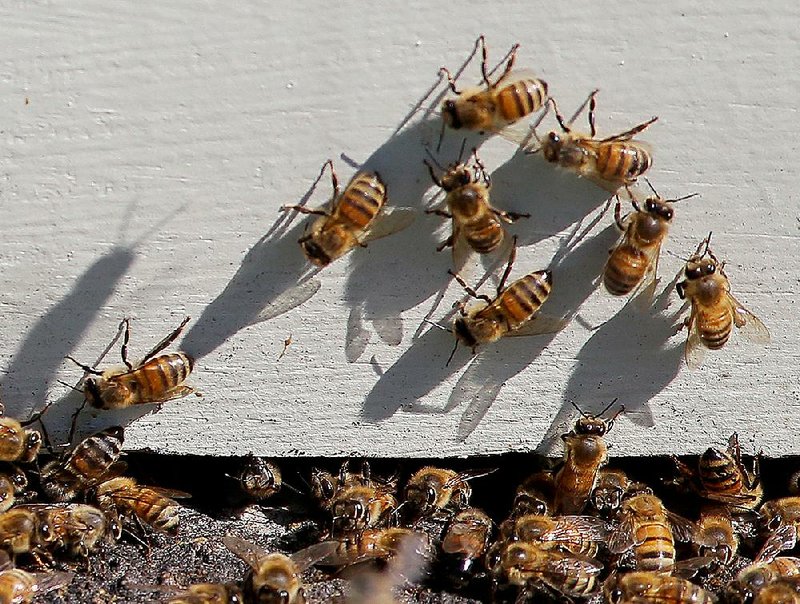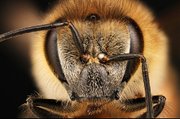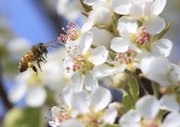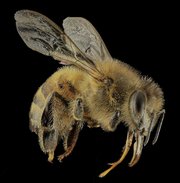Set aside your meetings and emails, at least for the next several minutes. Right now, you're a bee.
Recently in the journal Functional Ecology, researchers asked: What is a flower like from a bee's perspective, and what does the pollinator experience as it gathers pollen?
We're going to make a stab at answering that question, and we're taking you along for the ride. So c'mon, Buzz, it's time to leave your hive or your underground burrow and go forage for pollen.
B: OK, where do I start?
If you're a honeybee, keep an eye on fellow hive members as they return from their latest outings. They might use dance to give you clues to where to find a good pollen score.
Watch as a fellow bee moves in a figure eight, waggling only where the lines cross. The angle of that waggle tells you in which direction to head out from the hive to retrace your hive-mate's path to the good stuff, and the speed tells you how far to go.
Maybe you'll follow that same path, maybe not, and scientists are not sure what factors influence your actions. But research suggests that if food is scarce, you're more likely to pay attention to the waggle dance.
B: Suddenly I'm obsessed with pollen.
Bees like you have hunted for pollen seemingly forever. You use pollen, which is packed with protein and fats, to nourish yourselves, develop sex organs and feed your young.
But during the Late Cretaceous Period, when plants and animals were dying off all over the planet, plants adapted ways to limit how much pollen bees ate. One adaptation resulted in nectar. It has sugar and amino acids, and some bees began eating that instead.
Bees like you have learned to make judgments about nectar, such as which flowers keep the sweetest juice flowing the most often, and you remember those flowers by characteristics such as their scent or color.
But while nectar's sugars and amino acids help bees keep moving, pollen's protein and fat are essential to your development. You gotta have it.
B: How do I know when I've found it?
Your sense of smell is so powerful, you can use it to learn about pollens. You prefer the scent of flowers laden with the good stuff, especially those you've experienced before.
Scientists think you can detect pollen at a far distance.
They're still trying to figure out if you can smell the amino acids that make up the pollen, and if you can tell which flowers have more pollen by scent alone.
You can do that with nectar from far away. By detecting the smell of other bees that were there before you, you know not to waste your time with a depleted energy source.
B: Smells good. Can I taste it now, please?
When you get to a flower, it's time to have a sip of nectar. Although you generally don't gather nectar to bring it back to the hive, you'll slurp up some for energy and hold the rest in a special part of your digestive tract called the honey stomach or crop.
Then comes the fun part. You'll regurgitate some of the
nectar onto the dusty pollen granules you're gathering so they'll stick together, then pack those parcels into sacs on your legs before carrying them home.
Also called pollen baskets, these sacs, or corbiculae, are attached to the hind legs of some bee species' workers.
You won't eat the pollen while you're on the flower. But you may sample it, thanks to the taste receptors on your feet, antennae and mouth parts.
Your taste receptors respond to sugars, salt and toxins, and if you're a honeybee, perhaps proteins too. These flavors may help you remember the pollen and where you found it, and to learn which pollens contain toxins.
B: Then what am I looking for?
Well, sight probably isn't the strongest of your senses, strange as that seems to anyone who has read that each of your compound eyes contains about 7,000 mini eyes. Or that you have three small bonus eyes -- light sensors called ocelli -- arranged in a triangle above your antennae to help you navigate.
You see colors in a way humans don't. Your range of visible light is concentrated further toward the violet end of the spectrum, farther away from the red end. While you can't see red, you see ultraviolet. You see a world hidden from human eyes.
Many flowers have high-contrast ultraviolet color patterns like bull's-eyes or landing strips that effectively draw big circles around where to go to find nectar. Where a human might see a totally yellow flower, you see pale petals with vivid violet stripes radiating from a central axis.
Your eyes are small, and you're pretty nearsighted. But you can distinguish some colors, associate them with pollen and remember those links -- for up to a week.
Even if you don't see so very well, you see what you need to see to make a living. And you have other things in your favor, too.
When collecting pollen, many bees perform certain movements, like grooming and packing the pollen in particular ways. Bumblebees and carpenter bees, for instance, shake pollen from some flowers' anthers. They adjust how long or vigorously they shake, depending on how much pollen they're getting.
The hairs on your legs help gauge the pollen balls you're carrying there. You can probably sense how big they are and their shape. Perhaps you can even assess the difficulty of packing and transporting them.
B: Great advice. Will I remember any of it?
Scientists know that you can form associative memories with touch, and believe that touching a flower helps you remember your experience there.
Generally bees like you prefer to stick with pollen or flowers you've already experienced. It takes a lot of work to handle pollen, and you become accustomed to packing certain kinds of the stuff onto the hairs on your body.
Maybe you return to the same types of flowers because you already know the right tricks to get access to their pollen. But you're not too set in your ways.
After a while, you'll start sampling new pollen, especially if the kind you're used to starts to run out. And you'll get used to that pollen, too.
B: This bee gig is awesome.
You move through a world of fragrant, colorful floral bouquets. Now step out, take a deep breath -- and get back to work.
Celia Storey added some information to this report.
ActiveStyle on 05/01/2017




